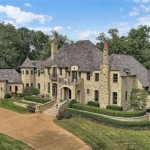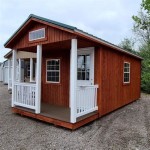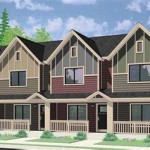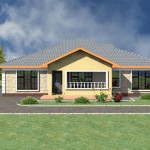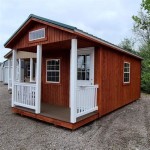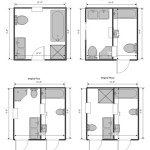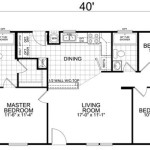Pole Barn With Loft Apartment Plans: Design, Construction, and Considerations
Pole barn with loft apartment plans are gaining popularity as a cost-effective and versatile housing solution. These structures combine the functionality of a traditional pole barn with the comfort and livability of an apartment, offering a flexible space for living, working, or recreational activities. The appeal lies in their relatively simple construction, adaptability to various design preferences, and potential for customization. Understanding the intricacies of planning, design, and construction is paramount to ensuring a successful project that meets safety standards, building codes, and individual needs.
A pole barn, also known as a post-frame building, utilizes large posts or poles embedded in the ground to provide structural support. This method often reduces the need for extensive foundation work, making it a potentially more economical option compared to traditional stick-built structures. The loft apartment component introduces a living space within the upper portion of the barn, maximizing vertical space and offering a separate area for residential use. These plans require careful consideration of various factors, including structural integrity, insulation, ventilation, plumbing, electrical systems, and adherence to local building regulations.
Key Point 1: Planning and Design Considerations
The initial phase of any pole barn with loft apartment project involves careful planning and design. This stage is critical for defining the scope of the project, establishing a budget, and ensuring that the final structure meets all requirements. Here are some key aspects to consider:
Defining the Purpose: The intended use of the pole barn and loft apartment will significantly influence the design. Will it serve as a primary residence, a guest house, a workshop with living quarters, or a rental property? The answer will determine the space allocation, required amenities, and overall layout of the structure. For example, a primary residence will necessitate a fully functional kitchen, bathrooms, and bedrooms, while a workshop may prioritize workspace and storage areas.
Size and Layout: Determining the appropriate size of the pole barn is crucial. Consider the required square footage for the loft apartment, storage areas, and any other functional spaces. The layout should optimize space utilization, ensuring a comfortable living environment and efficient workflow. Factors such as ceiling height, window placement, and staircase design will influence the overall feel of the loft apartment.
Structural Design and Load Calculations: A structural engineer should be consulted to ensure the pole barn design can support the added weight of the loft apartment, including furniture, appliances, and occupants. Load calculations must account for snow loads, wind loads, and seismic activity in the region. The spacing and size of the poles, as well as the framing of the loft floor, must be carefully engineered to provide adequate structural support.
Building Codes and Permits: Adherence to local building codes and regulations is non-negotiable. Research the specific requirements in the jurisdiction where the pole barn will be constructed. This includes obtaining necessary permits, adhering to zoning regulations, and meeting safety standards for electrical, plumbing, and HVAC systems. Failure to comply with building codes can result in costly fines and delays.
Insulation and Ventilation: Proper insulation is essential for maintaining a comfortable living environment in the loft apartment. Insulation helps regulate temperature, reduce energy consumption, and prevent condensation. Ventilation is equally important for removing moisture and preventing mold growth. Consider using insulation materials with high R-values (resistance to heat flow) and incorporating ventilation systems such as exhaust fans and ridge vents.
Aesthetic Considerations: While functionality is paramount, aesthetic appeal should not be overlooked. The exterior design of the pole barn can be customized to blend seamlessly with the surrounding landscape. Consider the siding material, roofing style, and window design to create a visually appealing structure. The interior design of the loft apartment can be tailored to individual preferences, incorporating features such as exposed beams, hardwood floors, and custom cabinetry.
Key Point 2: Construction Process and Materials
The construction phase involves translating the design plans into a tangible structure. Selecting appropriate materials and adhering to sound construction practices are critical for ensuring the longevity and safety of the pole barn with loft apartment.
Foundation and Pole Installation: While pole barns typically require less extensive foundation work compared to traditional buildings, proper pole installation is crucial. The poles are typically embedded in the ground using concrete footings or compacted gravel. The depth and spacing of the poles will depend on the structural design and local soil conditions. Ensuring proper alignment and plumbness of the poles is essential for the stability of the structure.
Framing and Sheathing: The framing of the walls and roof provides the structural support for the siding and roofing materials. Typically, lumber is used for framing, and the specific dimensions will depend on the load requirements. Sheathing, such as plywood or OSB (oriented strand board), is attached to the framing to provide a solid surface for attaching siding and roofing. The framing for the loft floor requires careful attention to ensure it can adequately support the weight of the apartment.
Exterior Siding and Roofing: The choice of siding and roofing materials will impact the aesthetic appeal, durability, and weather resistance of the pole barn. Common siding options include metal, wood, and vinyl. Metal siding is a popular choice due to its durability and low maintenance requirements. Roofing options include metal, asphalt shingles, and tile. Selecting materials that are appropriate for the local climate and resistant to pests and rot is essential.
Loft Apartment Construction: The construction of the loft apartment involves building the floor, walls, and ceiling. This phase requires careful attention to detail to ensure structural integrity and compliance with building codes. Installing proper insulation, wiring, and plumbing is essential for creating a comfortable and functional living space. Consider installing soundproofing materials to minimize noise transmission between the loft apartment and the rest of the pole barn.
Interior Finishes: The interior finishes of the loft apartment will impact the aesthetics and functionality of the space. Choose flooring materials, wall coverings, and ceiling treatments that are durable, easy to maintain, and visually appealing. Installing energy-efficient windows and doors will help reduce energy consumption and improve the comfort of the living space. Consider incorporating natural light sources, such as skylights or large windows, to create a bright and airy environment.
Plumbing, Electrical, and HVAC Systems: The installation of plumbing, electrical, and HVAC systems must be performed by qualified professionals and in accordance with local building codes. Proper wiring is essential for providing adequate power to the loft apartment. Plumbing systems must be installed to provide potable water and dispose of waste water. HVAC systems should be designed to efficiently heat and cool the living space, maintaining a comfortable temperature year-round.
Key Point 3: Legal and Financial Aspects
Beyond the technical aspects of design and construction, it's crucial to consider the legal and financial implications of building a pole barn with a loft apartment. Proper planning in these areas can prevent costly mistakes and ensure a smooth project execution.
Zoning Regulations and Permits: Thoroughly research local zoning regulations before starting the project. Some jurisdictions may have restrictions on the size, location, or type of buildings allowed on a property. Obtaining the necessary permits is essential for ensuring compliance with building codes and preventing legal issues. Failure to obtain permits can result in fines, delays, and even the forced removal of the structure.
Financing Options: Explore various financing options to determine the most suitable approach for funding the project. Options may include personal savings, home equity loans, construction loans, or agricultural loans. Securing pre-approval for financing can provide a clear understanding of the available budget and help streamline the construction process. Carefully evaluate the terms and conditions of each loan option to ensure it aligns with financial goals.
Insurance Coverage: Obtain adequate insurance coverage to protect the investment in the pole barn and loft apartment. This may include builder's risk insurance during the construction phase and homeowner's insurance after completion. Ensure that the insurance policy covers potential risks such as fire, wind damage, and liability. Consult with an insurance agent to determine the appropriate coverage for the specific project.
Contractor Selection: If hiring a contractor to oversee the construction process, carefully vet potential candidates. Check their credentials, licenses, and insurance coverage. Obtain multiple bids from different contractors and compare their pricing, experience, and references. A written contract should clearly outline the scope of work, payment schedule, and responsibilities of both parties. Thorough due diligence in contractor selection can significantly reduce the risk of delays, cost overruns, and substandard workmanship.
Property Taxes: Be aware that adding a loft apartment to a pole barn may increase property taxes. The assessed value of the property may increase due to the added living space and amenities. Consult with the local tax assessor to understand the potential impact on property taxes. Factor this cost into the overall budget to avoid unexpected expenses.
Rental Agreements (If Applicable): If the loft apartment is intended for rental purposes, carefully draft a rental agreement that complies with local landlord-tenant laws. The rental agreement should clearly outline the terms of the lease, including rent payment schedule, security deposit, and responsibilities of both the landlord and tenant. Obtain legal advice to ensure the rental agreement is legally sound and protects the interests of both parties.

Oakridge Apartment Barn Kit Wood Home Dc Structures

Barn Style Garage Plans Car Designs With Lofts Sixteen Diffe Layouts Complete Sets Of Economical Pole Construction

Monitor Style Pole Barn Plans

Enhance Your Home Pole Barn With Apartment Solutions

Structures Barn Pros

Pole Barn Loft Ideas With S The Everyday Farmhouse

Pole Barn Kit

Plan 001b 0001 The Garage

Barn Loft Construction Building Garage

50x35 Pole Barn With Apartment

